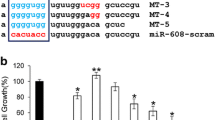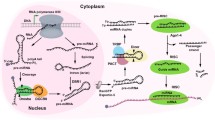Abstract
MicroRNAs (miRNAs) are small noncoding RNA molecules that negatively control expression of target genes in animals and plants. The microRNA-21 gene (mir-21) has been identified as the only miRNA commonly overexpressed in solid tumors of the lung, breast, stomach, prostate, colon, brain, head and neck, esophagus and pancreas. We initiated a screen to identify miR-21 target genes using a reporter assay and identified a potential miR-21 target in the 3′-UTR of the programmed cell death 4 (PDCD4) gene. We cloned the full-length 3′-UTR of human PDCD4 downstream of a reporter and found that mir-21 downregulated, whereas a modified antisense RNA to miR-21 upregulated reporter activity. Moreover, deletion of the putative miR-21-binding site (miRNA regulatory element, MRE) from the 3′-UTR of PDCD4, or mutations in the MRE abolished the ability of miR-21 to inhibit reporter activity, indicating that this MRE is a critical regulatory region. Western blotting showed that Pdcd4 protein levels were reduced by miR-21 in human and mouse cells, whereas quantitative real-time PCR revealed little difference at the mRNA level, suggesting translational regulation. Finally, overexpression of mir-21 in MCF-7 human breast cancer cells and mouse epidermal JB6 cells promoted soft agar colony formation by downregulating Pdcd4 protein levels. The demonstration that miR-21 promotes cell transformation supports the concept that mir-21 functions as an oncogene by a mechanism that involves translational repression of the tumor suppressor Pdcd4.



Similar content being viewed by others
References
Asangani IA, Rasheed SA, Nikolova DA, Leupold JH, Colburn NH, Post S et al. (2007). MicroRNA-21 (miR-21) post-transcriptionally downregulates tumor suppressor Pdcd4 and stimulates invasion, intravasation and metastasis in colorectal cancer. Oncogene. published online 29 October 2007.
Ashburner M, Ball CA, Blake JA, Botstein D, Butler H, Cherry JM et al. (2000). Gene ontology: tool for the unification of biology. The Gene Ontology Consortium. Nat Genet 25: 25–29.
Cai X, Hagedorn CH, Cullen BR . (2004). Human microRNAs are processed from capped, polyadenylated transcripts that can also function as mRNAs. RNA 10: 1957–1966.
Calin GA, Ferracin M, Cimmino A, Di Leva G, Shimizu M, Wojcik SE et al. (2005). A microRNA signature associated with prognosis and progression in chronic lymphocytic leukemia. N Engl J Med 353: 1793–1801.
Chan JA, Krichevsky AM, Kosik KS . (2005). MicroRNA-21 is an antiapoptotic factor in human glioblastoma cells. Cancer Res 65: 6029–6033.
Chen C, Ridzon DA, Broomer AJ, Zhou Z, Lee DH, Nguyen JT et al. (2005). Real-time quantification of microRNAs by stem-loop RT-PCR. Nucleic Acids Res 33: e179.
Chen Y, Knosel T, Kristiansen G, Pietas A, Garber ME, Matsuhashi S et al. (2003). Loss of PDCD4 expression in human lung cancer correlates with tumour progression and prognosis. J Pathol 200: 640–646.
Chen Y, Rodrik V, Foster DA . (2004). Alternative phospholipase D//mTOR survival signal in human breast cancer cells. Oncogene 24: 672–679.
Cmarik JL, Min H, Hegamyer G, Zhan S, Kulesz-Martin M, Yoshinaga H et al. (1999). Differentially expressed protein Pdcd4 inhibits tumor promoter-induced neoplastic transformation. Proc Natl Acad Sci USA 96: 14037–14042.
Diederichs S, Haber DA . (2006). Sequence variations of microRNAs in human cancer: alterations in predicted secondary structure do not affect processing. Cancer Res 66: 6097–6104.
Dong Z, Cmarik JL . (2002). Harvesting cells under anchorage-independent cell transformation conditions for biochemical analyses. Sci STKE 2002: PL7.
Frankel LB, Christoffersen NR, Jacobsen A, Lindow M, Krogh A, Lund AH . (2008). Programmed cell death 4 (PDCD4) is an important functional target of the microRNA miR-21 in breast cancer cells. J Biol Chem 283: 1026–1033.
Griffiths-Jones S, Grocock RJ, van Dongen S, Bateman A, Enright AJ . (2006). miRBase: microRNA sequences, targets and gene nomenclature. Nucleic Acids Res 34: D140–D144.
Hilliard A, Hilliard B, Zheng S-J, Sun H, Miwa T, Song W et al. (2006). Translational regulation of autoimmune inflammation and lymphoma genesis by programmed cell death 4. J Immunol 177: 8095–8102.
Iorio MV, Ferracin M, Liu CG, Veronese A, Spizzo R, Sabbioni S et al. (2005). MicroRNA gene expression deregulation in human breast cancer. Cancer Res 65: 7065–7070.
Jansen AP, Camalier CE, Colburn NH . (2005). Epidermal expression of the translation inhibitor programmed cell death 4 suppresses tumorigenesis. Cancer Res 65: 6034–6041.
Jansen AP, Camalier CE, Stark C, Colburn NH . (2004). Characterization of programmed cell death 4 in multiple human cancers reveals a novel enhancer of drug sensitivity. Mol Cancer Ther 3: 103–110.
John B, Enright AJ, Aravin A, Tuschl T, Sander C, Marks DS . (2004). Human microRNA targets. PLoS Biol 2: e363.
Johnson SM, Grosshans H, Shingara J, Byrom M, Jarvis R, Cheng A et al. (2005). RAS is regulated by the let-7 microRNA family. Cell 120: 635–647.
Krek A, Grun D, Poy MN, Wolf R, Rosenberg L, Epstein EJ et al. (2005). Combinatorial microRNA target predictions. Nat Genet 37: 495.
Lawrie CH, Soneji S, Marafioti T, Cooper CD, Palazzo S, Paterson JC et al. (2007). Microrna expression distinguishes between germinal center B cell-like and activated B cell-like subtypes of diffuse large B cell lymphoma. Int J Cancer 121: 1156–1161.
Lee S, Bang S, Song K, Lee I . (2006). Differential expression in normal-adenoma-carcinoma sequence suggests complex molecular carcinogenesis in colon. Oncol Rep 16: 747–754.
Lewis BP, Burge CB, Bartel DP . (2005). Conserved seed pairing, often flanked by adenosines, indicates that thousands of human genes are microRNA targets. Cell 120: 15–20.
Li L, Ross AH . (2007). Why is PTEN an important tumor suppressor? J Cell Biochem 102: 1368–1374.
Ma G, Guo KJ, Zhang H, Ozaki I, Matsuhashi S, Zheng XY et al. (2005). Expression of programmed cell death 4 and its clinicopathological significance in human pancreatic cancer. Zhongguo Yi Xue Ke Xue Yuan Xue Bao 27: 597–600.
Meister G, Landthaler M, Dorsett Y, Tuschl T . (2004). Sequence-specific inhibition of microRNA- and siRNA-induced RNA silencing. RNA 10: 544–550.
Meng F, Henson R, Lang M, Wehbe H, Maheshwari S, Mendell JT et al. (2006). Involvement of human micro-RNA in growth and response to chemotherapy in human cholangiocarcinoma cell lines. Gastroenterology 130: 2113–2129.
Meng F, Henson R, Wehbe-Janek H, Ghoshal K, Jacob ST, Patel T . (2007). MicroRNA-21 regulates expression of the PTEN tumor suppressor gene in human hepatocellular cancer. Gastroenterology 133: 647–658.
Miranda KC, Huynh T, Tay Y, Ang YS, Tam WL, Thomson AM et al. (2006). A pattern-based method for the identification of microRNA binding sites and their corresponding heteroduplexes. Cell 126: 1203–1217.
Roldo C, Missiaglia E, Hagan JP, Falconi M, Capelli P, Bersani S et al. (2006). MicroRNA expression abnormalities in pancreatic endocrine and acinar tumors are associated with distinctive pathologic features and clinical behavior. J Clin Oncol 24: 4677–4684.
Root DE, Hacohen N, Hahn WC, Lander ES, Sabatini DM . (2006). Genome-scale loss-of-function screening with a lentiviral RNAi library. Nat Methods 3: 715–719.
Si ML, Zhu S, Wu H, Lu Z, Wu F, Mo YY . (2007). miR-21-mediated tumor growth. Oncogene 26: 2799–2803.
Volinia S, Calin GA, Liu C-G, Ambs S, Cimmino A, Petrocca F et al. (2006). A microRNA expression signature of human solid tumors defines cancer gene targets. Proc Natl Acad Sci USA 103: 2257–2261.
Wang T, Zhang X, Obijuru L, Laser J, Aris V, Lee P et al. (2007). A micro-RNA signature associated with race, tumor size, and target gene activity in human uterine leiomyomas. Genes Chromosomes Cancer 46: 336–347.
Yang HS, Cho MH, Zakowicz H, Hegamyer G, Sonenberg N, Colburn NH . (2004). A novel function of the MA-3 domains in transformation and translation suppressor Pdcd4 is essential for its binding to eukaryotic translation initiation factor 4A. Mol Cell Biol 24: 3894–3906.
Yang HS, Jansen AP, Komar AA, Zheng X, Merrick WC, Costes S et al. (2003). The transformation suppressor Pdcd4 is a novel eukaryotic translation initiation factor 4A binding protein that inhibits translation. Mol Cell Biol 23: 26–37.
Yang HS, Jansen AP, Nair R, Shibahara K, Verma AK, Cmarik JL et al. (2001). A novel transformation suppressor, Pdcd4, inhibits AP-1 transactivation but not NF-kappaB or ODC transactivation. Oncogene 20: 669–676.
Yu K, Toral-Barza L, Discafani C, Zhang WG, Skotnicki J, Frost P et al. (2001). mTOR, a novel target in breast cancer: the effect of CCI-779, an mTOR inhibitor, in preclinical models of breast cancer. Endocr Relat Cancer 8: 249–258.
Zhu S, Si ML, Wu H, Mo YY . (2007). MicroRNA-21 targets the tumor suppressor gene tropomyosin 1 (TPM1). J Biol Chem 282: 14328–14336.
Acknowledgements
YL is supported by the career development program and a pilot grant from the Center for Genomics and Integrated Biology at University of Louisville funded by NIEHS P30ES014443. This research was supported in part by NCI R21-CA124811 to CMK. ML is supported by PUJIANG program from the Committee of Shanghai Science and Technology (06PJ14105).
Author information
Authors and Affiliations
Corresponding author
Additional information
Supplementary Information accompanies the paper on the Oncogene website (http://www.nature.com/onc)
Rights and permissions
About this article
Cite this article
Lu, Z., Liu, M., Stribinskis, V. et al. MicroRNA-21 promotes cell transformation by targeting the programmed cell death 4 gene. Oncogene 27, 4373–4379 (2008). https://doi.org/10.1038/onc.2008.72
Received:
Revised:
Accepted:
Published:
Issue Date:
DOI: https://doi.org/10.1038/onc.2008.72
- Springer Nature Limited
Keywords
This article is cited by
-
RETRACTED ARTICLE: Catalytic Au/PEDOT/Pt micromotors for cancer biomarker detection and potential breast cancer treatment
Applied Nanoscience (2023)
-
The Significant Role of microRNAs in Gliomas Angiogenesis: A Particular Focus on Molecular Mechanisms and Opportunities for Clinical Application
Cellular and Molecular Neurobiology (2023)
-
Exosome-based strategies for diagnosis and therapy of glioma cancer
Cancer Cell International (2022)
-
Genetic and molecular biology of gastric cancer among Iranian patients: an update
Egyptian Journal of Medical Human Genetics (2022)
-
MicroRNA-21 is immunosuppressive and pro-metastatic via separate mechanisms
Oncogenesis (2022)




